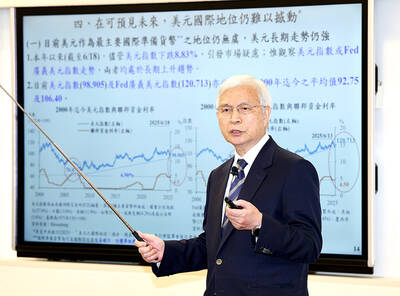Largan Precision Co (大立光) and Catcher Technology Co (可成) on Saturday reported rising revenue for last month from March, after most companies in the handset components sector reported weak first-quarter results amid the sluggish global smartphone market.
As leading suppliers in the global handset supply chain, the two companies’ revenue streams are closely monitored by market watchers to determine whether the smartphone market will follow expectations and show a recovery this quarter, or deteriorate faster than expected.
Handset camera lens maker Largan reported better-than-expected revenue for last month on the back of a continued improvement in yield rates and favorable product trends.
The Taichung-based company saw consolidated revenue reach NT$3.47 billion (US$116.8 million) last month, up 10.34 percent from the previous month.
Last month’s sales were still 6.02 percent lower than a year earlier, according to figures that Largan posted on its Web site on Saturday.
In the first four months of this year, consolidated revenue totaled NT$12.34 billion, down 14.84 percent from NT$14.5 billion during the same period last year.
The bright spot is that higher-priced lenses for cameras of 10 or more megapixels still made up a larger portion of shipments, accounting for 70 to 80 percent of the company’s overall shipments last month, while 8-megapixel products accounted for 10 to 20 percent and the 5-megapixel line contributed up to 10 percent, the company said.
Largan — whose customers include Apple Inc and several Android smartphone vendors — last month said it was upbeat about sales for this month and next month, compared with NT$3.14 billion in March, given the company’s efforts to improve production yield rates.
With potential strong demand for OLED iPhones in the second half of the year and the emerging adoption of triple-camera lenses by some handset vendors, as well as resilient prices and gross margin of the company’s products, Largan could see a year-on-year recovery in sales and operating profit from this month, Yuanta Securities Investment Consulting Co (元大投顧) analyst Jeff Pu (蒲得宇) said in a note on Wednesday last week.
Pu said Huawei Technologies Co (華為) is expected to drive triple-camera lens adoption by introducing a lower-spec device for the Mate 20 model, while Apple is likely to launch a new iPhone model with a triple-lens rear camera in the second half of next year.
Assuming that other vendors would follow suit and therefore boost adoption of the triple-lens design, it could “provide a much-needed improvement in Largan’s capacity utilization rate,” Pu said.
Meanwhile, casing maker Catcher posted revenue of NT$6.6 billion for last month, a surge of 1.3 percent from the previous month and up 28.54 percent from the same period a year earlier.
Cumulative revenue in the first four months totaled NT$27.01 billion, a 36.99 percent annual increase from NT$19.72 billion, the Tainan-based company said.
Catcher also released its audited first-quarter results, which showed that net profit increased 75 percent year-on-year to NT$3.66 billion, the company’s highest level for the same period, with earnings per share of NT$4.75.
However, gross margin declined to 41.75 percent and operating margin to 32.6 percent, both the lowest levels since the second quarter of 2016, company data showed.
Earnings per share in the first quarter came lower than KGI Securities Investment Advisory Co’s (凱基投顧) estimate of NT$5.27 and a market consensus forecast of NT$6.7.
Analysts said ahead of the data release that Catcher’s sales would be particularly strong in the second half of this year, closely aligned with customers’ scheduled launches of new products.
“The company’s sales in the first quarter were affected by weak iPhone demand and sales in the second quarter could be affected by the delayed launch of a new MacBook Air model,” KGI researchers led by Angela Hsiang (向子慧) said in a note on Monday last week.
KGI predicted that sales in the second half would be 65 percent higher than in the first half, and that profit in the second half would grow 124 percent from the previous half.
Overall, Catcher is likely to maintain its lead over metal casing peers in terms of profitability this year, thanks to its highly automated production lines and in-house development of cutters, tooling, fixture and feeder parts, which would allow the company to enjoy lower manufacturing costs, while having the capability to rapidly increase short-term production with a high yield and efficiency rate, KGI said.

NOT JUSTIFIED: The bank’s governor said there would only be a rate cut if inflation falls below 1.5% and economic conditions deteriorate, which have not been detected The central bank yesterday kept its key interest rates unchanged for a fifth consecutive quarter, aligning with market expectations, while slightly lowering its inflation outlook amid signs of cooling price pressures. The move came after the US Federal Reserve held rates steady overnight, despite pressure from US President Donald Trump to cut borrowing costs. Central bank board members unanimously voted to maintain the discount rate at 2 percent, the secured loan rate at 2.375 percent and the overnight lending rate at 4.25 percent. “We consider the policy decision appropriate, although it suggests tightening leaning after factoring in slackening inflation and stable GDP growth,”

DIVIDED VIEWS: Although the Fed agreed on holding rates steady, some officials see no rate cuts for this year, while 10 policymakers foresee two or more cuts There are a lot of unknowns about the outlook for the economy and interest rates, but US Federal Reserve Chair Jerome Powell signaled at least one thing seems certain: Higher prices are coming. Fed policymakers voted unanimously to hold interest rates steady at a range of 4.25 percent to 4.50 percent for a fourth straight meeting on Wednesday, as they await clarity on whether tariffs would leave a one-time or more lasting mark on inflation. Powell said it is still unclear how much of the bill would fall on the shoulders of consumers, but he expects to learn more about tariffs

Greek tourism student Katerina quit within a month of starting work at a five-star hotel in Halkidiki, one of the country’s top destinations, because she said conditions were so dire. Beyond the bad pay, the 22-year-old said that her working and living conditions were “miserable and unacceptable.” Millions holiday in Greece every year, but its vital tourism industry is finding it harder and harder to recruit Greeks to look after them. “I was asked to work in any department of the hotel where there was a need, from service to cleaning,” said Katerina, a tourism and marketing student, who would

i Gasoline and diesel prices at fuel stations are this week to rise NT$0.1 per liter, as tensions in the Middle East pushed crude oil prices higher last week, CPC Corp, Taiwan (台灣中油) and Formosa Petrochemical Corp (台塑石化) said yesterday. International crude oil prices last week rose for the third consecutive week due to an escalating conflict between Israel and Iran, as the market is concerned that the situation in the Middle East might affect crude oil supply, CPC and Formosa said in separate statements. Front-month Brent crude oil futures — the international oil benchmark — rose 3.75 percent to settle at US$77.01